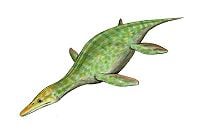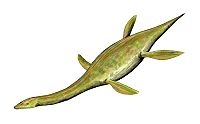Pliosaur
| Pliosaur
| ||||||||||||
|---|---|---|---|---|---|---|---|---|---|---|---|---|
 Peloneustes philarchus
| ||||||||||||
| Scientific classification | ||||||||||||
| ||||||||||||
|
see text |
The Pliosaurs ("fin lizards") were marine reptiles from the Jurassic and Cretaceous Periods. They originally included members of the family Pliosauridae, of the Order Plesiosauria, but several other genera and families are now also included; the number and details of which vary according to the classification used. The name is derived from Greek: πλειω from the verb 'to sail' or πλειων meaning 'fin' and σαυρος meaning 'lizard'. The pliosaurs, along with their relatives, the true plesiosaurs, and other members of Sauropterygia, were not dinosaurs.
This group was characterised by having a short neck and an elongated head, in contrast to the long-necked plesiosaurs. They were more crocodile-shaped. However, the four-paddle swimming action, using the large flipper-like limbs was shared with plesiosaurs and they were possibly better adapted to deeper waters. They were carnivorous and their long and powerful jaws carried many sharp, conical teeth. Pliosaurs range from 4 to 15 meters in length.[1][2] Their prey may have included fish, ichthyosaurs and other plesiosaurs.
Typical genera include Macroplata, Kronosaurus, Liopleurodon, Pliosaurus and Peloneustes. Fossil specimens have been found in England, Mexico, South America, Australia and the Arctic region near Norway.
Many very early (from the Rhaetian (Latest Triassic) and Early Jurassic) primitive pliosaurs were very like plesiosaurs in appearance and indeed used to be included in the family Plesiosauridae.
Taxonomy
The taxonomy presented here is mainly based on the plesiosaur cladistic analysis proposed by O'Keefe in 2001.[3]
- Suborder: †Pliosauroidea Welles, 1943 sensu O'Keefe, 2001
- ? †Bishanopliosaurus Dong, 1980
- ? †Megalneusaurus Knight, 1898
- ? †Pachycostasaurus Cruickshank, Martill & Noe, 1996
- ? †Sinopliosaurus G. Young, 1820
- †Thalassiodracon Storrs & Taylor, 1996
- †Archaeonectrus Novozhilov, 1964
- †Attenborosaurus Bakker, 1993
- †Eurycleidus Andrews, 1922
- Family: †Rhomaleosauridae (Nopsca, 1928) Kuhn, 1961 sensu O'Keefe,2001
- †Umoonasaurus Kear, Schroeder & Lee, 2006
- ? †Yuzhoupliosaurus Zhang, 1985
- ? †Hexatarostinus
- †Rhomaleosaurus Seeley, 1874
- †Simolestes Andrews, 1909
- Family: †Leptocleididae White, 1940
- †Leptocleidus Andrews, 1922
- Family: †Pliosauridae Seeley, 1874 sensu O'Keefe, 2001
- ? †Plesiopleurodon Carpenter, 1996
- ? †Polyptychodon Non Owen, 1841
- ? †Maresaurus Gasparini, 1997
- †Macroplata Swinton, 1930
- †Hauffiosaurus O’Keefe, 2001
- †Kronosaurus Longman, 1924
- †Peloneustes Lydekker, 1889
- †Liopleurodon Sauvage, 1873
- †Brachauchenius Williston, 1903
- †Pliosaurus Owen, 1841
ReferencesISBN links support NWE through referral fees
- ↑ zoom dinosaurs
- ↑ Sea reptile is biggest on record. BBC News, February 27, 2008.
- ↑ O'Keefe, F. R. 2001. A cladistic analysis and taxonomic revision of the Plesiosauria (Reptilia: Sauropterygia). Acta Zoologica Fennica 213: 1-63.
See also
Further reading
- The Plesiosaur Directory - pliosaur page
- Possibly the first full skeleton of a pliosaur was found in October, 2006.
- The monster from the North
Credits
New World Encyclopedia writers and editors rewrote and completed the Wikipedia article in accordance with New World Encyclopedia standards. This article abides by terms of the Creative Commons CC-by-sa 3.0 License (CC-by-sa), which may be used and disseminated with proper attribution. Credit is due under the terms of this license that can reference both the New World Encyclopedia contributors and the selfless volunteer contributors of the Wikimedia Foundation. To cite this article click here for a list of acceptable citing formats.The history of earlier contributions by wikipedians is accessible to researchers here:
The history of this article since it was imported to New World Encyclopedia:
Note: Some restrictions may apply to use of individual images which are separately licensed.




